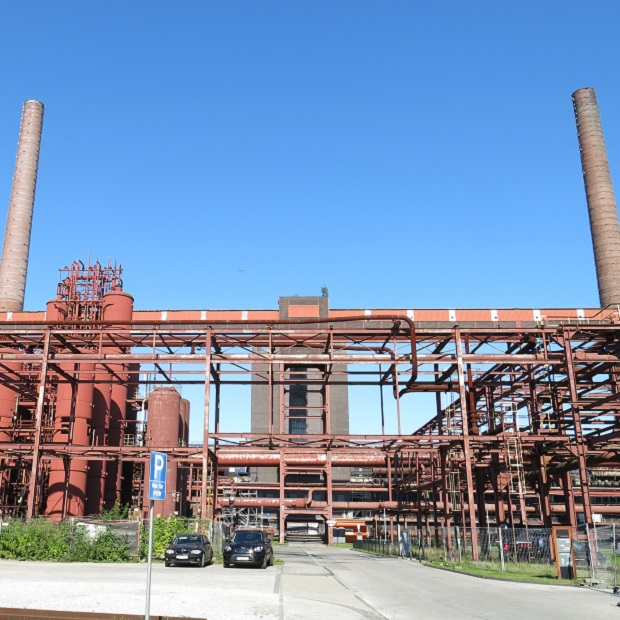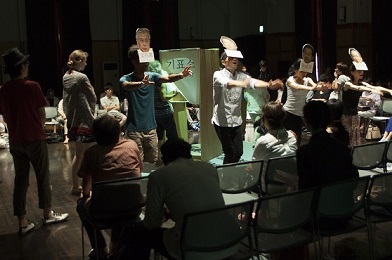
Vol.7
InterviewAugust 4, 2014 UP
European Capital of Culture and Art Center Possibilities
From PACT Zollverein in Essen and Marseille’s montévidéo
- Words and photography:Mayumi Yamamoto (Kyoto Art Center Program Director)
From the end of September through October I was able to visit Essen in Western Germany and Marseille in the South of France. While the driving force for the trip was a business meeting regarding Kyoto Art Center’s new collaboration with art centers from these two cities for the soon-to-start Feldstärke International, this is a great opportunity to introduce these cities and their art centers.
Essen prospered as a coal mining district in the mid-19th Century, but after the decline of the industry from 1986 it has reinvented itself as a successful artistic and cultural capital.
Within a part of the remains of a coal mining area, recognized by UNESCO, lies the renovated theatre style art center PACT Zollverein. The shower facility (which, they say, was used by up to 3000 miners in its peak) has now been renovated to serve as a theatre and studio concentrated on contemporary art and to develop various projects as a composite institution. In the first floor there are studios and offices and the second floor has a small and large theatre. At the same time as carrying out things like experimental stage performances and programs for children, most of the artists in residence are also conducting various activities. The staff consists of an artistic director, a managing director, 4 program managers, 2 public relations staff, and 3 technical staff. Including all of the various facility administration, there are a total of 15 staff.

PACT Zollverein exterior
The Zollverein coal mine itself spreads out over a huge area of land, and aside from Pact, there are also things like a coal mining museum, design museum, and an installation by Ilya and Emilia Kabakov. The powerful and extremely beautiful buildings on the site display a heavy Bauhaus influence. Even now, there are several buildings standing that have been left untouched. Incidentally, the design school that was planned by SANAA was also built on this premises in 2006.
Also of note is the Ruhrtriennale festival held in the Ruhr region every year from August 23rd until September 6th (organised by Kultur Ruhr GmbH). Apparently, it is called a triennale, despite being held yearly, due to the 3 year shifts done by the directors. Various events are held throughout the festival together with PACT as an organization. The scope of the Ruhrtriennale itself is very wide and it uses many places such as industrial remains outside of Zollverein for exhibition spaces and performance grounds.

Heiner Goebbels "Stifters Dinge" Heiner Goebbels "Stifters Dinge" installation (Ruhrtriennale 2013)
Furthermore, to coincide with the Ruhrtriennale this year, the alfresco exhibition EMSCHER KUNST (sponsored by the likes of the water management association) was also held from September 22nd through until October 6th. Charming and dynamic artwork was shown along the huge riverside areas of the two rivers running parallel from East to West besides Essen. A project was held in which 1000 different tents, made from 10 kinds of designs such as Ai WeiWei’s Shanghai crabs, could be chosen, pitched, and slept in. Installations by other artists familiar in Japan, such as Daniel Buren, could also be seen.

Christo "BIG AIR PACKAGE”, 2013, Gasometer Oberhausen
On this occasion, the work that really stood out as the most impressive was the installation by Christo, BIG AIR PACKAGE, shown in the Gasometer Oberhausen, at that time the biggest gas tank in Europe. Exhibitions are held at the Gasometer Oberhausen every 1 or 2 years, this is the second showing of Christo since 1999, other artists have included the likes of Bill Viola. A huge white balloon was fixed inside the gigantic tank, into which the audience could enter. Words can’t describe the experience of such a huge expanse, the mood became silent and contemplative inside the breathtaking pure white space. It was also possible to go up to the roof of the gas tank via an external elevator and appreciate the view across Germany all the way to Holland. The land in the area has nothing that could be called a mountain, more just small hills, and we were able to spot several nuclear power stations, still in operation, dotted here and there across the beautiful, flat landscape.

From the roof of the Gasometer Oberhausen
There are some reasons why Essen has wrestled with cultural initiatives. After accepting the demise of the coal mines, despite the sentimentality and economic fortune that they had brought to the people, the city became a story of regeneration through culture as a way of survival. The PACT program manager Marlies PILLHOFER says that “Although there are lots of new employment possibilities for the young generation through artistic activities, there is now a situation where we have a separation between those who previously worked in the coal mines and the new generation of young people who moved to Essen”. Improvements in the transportation facilities of the 2010 European Capital of Culture have made it easier for interaction with tourists coming from outside, however there is a very limited budget. In the same way, although the festival is continuing to be held, it has been remarked that it is a lot more inconvenient than before.

PACT Zollverein theater

montévidéo exterior
There is an atmosphere of energy in the air as new projects and establishments jostle to open in the city of Marseille, selected as European Capital of Culture in 2013.
In the central part of the city lies montévidéo, an art center centred on literature and music. Established in a refurbished wallpaper factory, this too is an historical building. We arrived at night time just as the evening performance has finished and many people were gathered outside on the beautiful terrace at the entrance, chatting with drink in hand. The central space on entering the building is a cafeteria, and there is a small and large theatre on both the first and the second floor. Furthermore, in a separate building there is a music studio and a residence space which are usually being used by visiting artists. Montévidéo is not executively-led, rather it was established as an artist-run facility and now receives public funding to carry out activities. The management is primarily under the control of Hubert Colas, an artist, producer, and stage designer, and things like the planning of modern music programme, CD production, and recording is handled by Jean-Marc Montera. Hubert Colas also established the international art festival, actoral, which has been held every fall since 2001 and this year, its 13th year, will be from September 24th until October 13th. Apart from montévidéo, there are around 50 programmes being run in other theatres and alternative spaces in Marseille including plays, music, lectures and visual art.

Cafeteria inside montévidéo
While on the one hand Marseille is a city overflowing with the charm of the glittering sun of Southern France, the clear blue waters of the Mediterranean Sea and white-walled houses, on the other, it is a town plagued by increased robberies and drug crimes, to that extent that the first words said about it are often “be careful of pickpockets!”. In the midst of all that, it has been selected as this year’s European Capital of Culture and new art galleries and museums are continuing to spring up as huge budgets are invested in its cultural face. Only just opened this year, the Musée des civilisations de l'Europe et de la Méditerranée seems to be gaining popularity as a new sightseeing spot. It is situated in a fortress in the Bay of Marseille, commanding a view over the Mediterranean Sea, as well as a brand new building.
The European Capital of Culture was started in Athens in 1985. Every year, a municipal is chosen by the EU, a cultural budget is then assigned and there is a concentrated drive of enterprize. Some cities are brimming with charm and magnificent history, such as Essen (2010) and Marseille (2013), but at the same time, there are cities that have big problems. Within the European Capital of Culture, there are also cities that have complicated issues such as public order, unemployment, or race problems, to which budgets are invested as a plan to boost their public image. Accordingly, the feeling can’t be escaped that culture is being gracefully utilised in order to transform the diversity, out of which various problems often spring, into the vitality of the city. Nonetheless, there is a strong sense that those involved with cultural activities in these places have accepted this state of affairs and are trying their best to make the system work. It was felt that the deep history, the local pride, and the coaxing out of the charm of city that lies in the cultural foundations, is something we hope to share in Kyoto.
From this year onwards, Japan, Korea, and China are joining together to start the new East Asia City of Culture project, which is modeled on the European Capital of Culture. It is worth paying attention to how much efforts like these will change the cultural paradigm of Asia and the world.

Feldstärke International
Feldstärke International is a program started in 2005 and planned by PACT Zollverein’s artistic director, Stephan HILTERHAUS. In 2014, Kyoto Art Center will become the first East Asian partner to join in operations together with montévidéo in Marseille.
10 students from different specialisms in universities of each country (making a total of 30 students) will spend one week in each city making collaborative work themed around the characteristics or problems of the city.
The details were announced in November, 2013, please check the Kyoto Art Center website or news bulletins.

